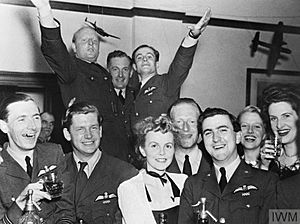No. 92 Squadron RAF facts for kids
Quick facts for kids No. 92 (East India) Squadron RAF |
|
|---|---|
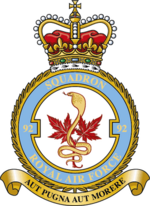
Squadron badge
|
|
| Active | 1 September 1917 – 1 April 1918 (RFC) 1 April 1918 – 7 August 1919 (RAF) 10 October 1939 – 30 December 1946 31 January 1947 – 31 March 1977 1 April 1977 – 1 July 1991 23 September 1992 – 1 October 1994 30 June 2009 – present |
| Country | |
| Branch | |
| Type | Non-flying squadron |
| Role | Tactics and training squadron |
| Part of | Air Warfare Centre |
| Home station | RAF Waddington |
| Nickname(s) | East India |
| Motto(s) | Aut pugna aut morere (Latin for 'Either fight or die') |
| Battle honours |
|
| Insignia | |
| Squadron badge heraldry | A cobra entwining a sprig of maple leaf. The maple leaf signifies the squadron's association as a Canadian unit in the First World War whilst the cobra represents that the squadron was one of the East India gift squadrons during the Second World War. Awarded by King George VI in January 1942. |
| Post-1950 squadron roundel |  |
| Squadron codes | GR (Apr 1939 – Sep 1939; Oct 1939 – May 1940) QJ (May 1940 – Dec 1946) DL (Jan 1947 – Sep 1950) (formerly No. 91 Sqn) 8L (Sep 1950 – Apr 1951) |
No. 92 Squadron, also called the No. 92 (East India) Squadron, is a special unit of the Royal Air Force (RAF). It helps test and train pilots and is based at RAF Waddington in Lincolnshire, UK.
It started on September 1, 1917, as a fighter squadron during the First World War. They flew planes to fight enemy aircraft and help soldiers on the ground in France. After the war, the squadron was closed down in 1919.
The squadron was started again in 1939, just before the Second World War. It became one of the first RAF units to fly the famous Supermarine Spitfire. They played a big part in the Battle of Britain.
After the Second World War, No. 92 Squadron continued to fly different types of fighter jets. From 1961 to 1962, they were even the RAF's official aerobatic team, known as the Blue Diamonds. Today, it is called No. 92 Tactics and Training Squadron, focusing on teaching and improving air combat skills.
Contents
Squadron History
First World War Service
No. 92 Squadron began as part of the Royal Flying Corps on September 1, 1917. They trained with planes like the Sopwith Pup and Royal Aircraft Factory SE.5a. When the Royal Air Force was formed on April 1, 1918, the squadron became part of it.
In July 1918, they moved to France and started flying missions. They were very active during the Second Battle of the Somme and other fights on the Western Front. The squadron was known for its success, claiming 38 victories against enemy planes. After the war ended, the squadron was closed down on August 7, 1919.
Second World War Service
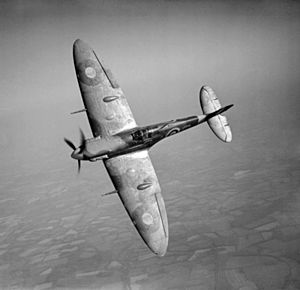
No. 92 Squadron was started again on October 10, 1939, at RAF Tangmere. They first flew Bristol Blenheim planes, but in March 1940, they received the fast Supermarine Spitfire Mk.I. They became ready for action on May 9.
The squadron first fought during the Dunkirk evacuation, helping to protect soldiers on the beaches. Later, they were key players in the Battle of Britain, flying from RAF Biggin Hill.
In February 1942, the squadron moved to Egypt to support the Allies in North Africa. They finally received their Spitfires in August and began flying missions over the El Alamein area. No. 92 Squadron provided air cover during the Second Battle of El Alamein. They also took part in "Operation Flax," where they helped destroy many enemy aircraft.
After the Allies won in North Africa, the squadron moved to Malta in June 1943. They then helped the 8th Army during the invasions of Sicily and Italy. No. 92 Squadron followed the armies up the Italian coast. During the Second World War, the squadron claimed 317 victories, which was the highest number in the RAF.
Cold War Era
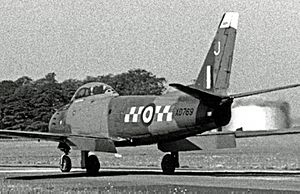
After the Second World War, No. 92 Squadron was closed down in Austria in December 1946. However, it was reformed quickly on January 31, 1947, as No. 92 (Fighter) Squadron. They flew Gloster Meteor jets and later the Canadair Sabre F.4.
In 1961, No. 92 (F) Squadron was chosen to be the RAF's official aerobatic team. They were called the Blue Diamonds and flew 16 bright blue Hawker Hunter F.6 jets. They performed amazing displays, including looping a formation of 18 aircraft! They continued to perform even after they switched to the English Electric Lightning F.2 jets in 1963.
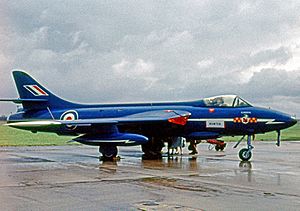
In December 1965, the squadron moved to RAF Germany. They stayed there until March 1977. In January 1977, a new No. 92 (F) Squadron started training with McDonnell Douglas Phantom FGR.2 jets.
In 1990, Phantoms from No. 92 (F) Squadron were sent to RAF Akrotiri in Cyprus to help with air defence during the Invasion of Kuwait. The squadron was closed down again on July 1, 1991.
Modern Role: Tactics and Training
On September 23, 1992, No. 92 Squadron was reformed as a training unit at RAF Chivenor. They flew British Aerospace Hawk T.1 jets for weapons training. This role ended in October 1994, and the squadron was disbanded again.
After 14 years, No. 92 Squadron was reformed on June 30, 2009. It became part of the Air Warfare Centre. On February 1, 2018, its name changed to No. 92 Tactics and Training Squadron.
Today, No. 92 Squadron helps design and run important training exercises, like "Exercise Cobra Warrior." This exercise helps pilots from different countries, like Germany, Italy, and Israel, train together.
Aircraft Flown
Over its long history, No. 92 Squadron has flown many different types of aircraft:
- Sopwith Pup (1917–1918)
- Royal Aircraft Factory SE.5a (1918)
- Bristol Blenheim Mk.IF (1939–1940)
- Supermarine Spitfire Mk.I/Ib (1940–1941)
- Supermarine Spitfire Mk.Vb (1941–1943)
- Supermarine Spitfire Mk.Vc (1942–1943)
- Supermarine Spitfire Mk.IX (1943–1946)
- Supermarine Spitfire Mk.VIII (1943–1946)
- Gloster Meteor F.3 (1947–1948)
- Gloster Meteor F.4 (1948–1950)
- Gloster Meteor F.8 (1950–1954)
- Canadair Sabre F.4 (1954–1956)
- Hawker Hunter F.4 (1956–1957)
- Hawker Hunter F.6 (1957–1963)
- English Electric Lightning F.2 (1963–1971)
- English Electric Lightning F.2A (1968–1977)
- McDonnell Douglas F-4M Phantom FGR.2 (1977–1991)
- British Aerospace Hawk T.1/T.1A (1992–1994)
Famous Pilots (Aces)
Several skilled pilots, known as "aces" for shooting down many enemy aircraft, served with No. 92 Squadron:
- Robert Stanford Tuck: Destroyed 27 enemy aircraft.
- Donald Ernest Kingaby: Had 21 confirmed kills, mostly against Messerschmitt Bf 109s.
- Allan Wright: Achieved 11 kills.
- Ronnie Fokes: Had nine kills.
- Brian Kingcome: Achieved eight kills.
- John Fraser Drummond: Had eight kills.
- Tony Bartley: Achieved eight kills with 92 Squadron (12 total in WW2).
- Adolf Pietrasiak: A Polish Air Force pilot with eight kills.
Special Honour
In 1950, a steam locomotive was named "92 Squadron." This train, No. 34081, was part of the Battle of Britain class. It was saved from being scrapped in 1976 and has been restored. It still runs today on heritage railways, keeping the squadron's name alive.
See also
- List of RAF squadrons



